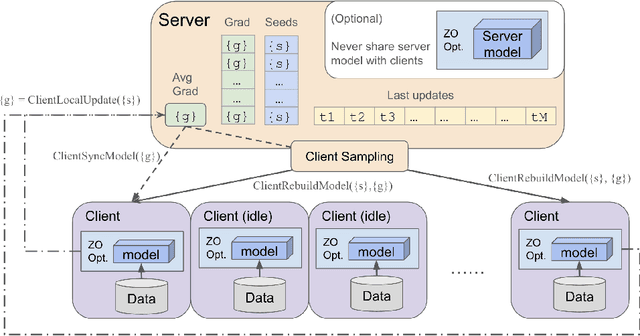Zidong Liu
Can Language Models Compose Skills In-Context?
Oct 27, 2025Abstract:Composing basic skills from simple tasks to accomplish composite tasks is crucial for modern intelligent systems. We investigate the in-context composition ability of language models to perform composite tasks that combine basic skills demonstrated in in-context examples. This is more challenging than the standard setting, where skills and their composition can be learned in training. We conduct systematic experiments on various representative open-source language models, utilizing linguistic and logical tasks designed to probe composition abilities. The results reveal that simple task examples can have a surprising negative impact on the performance, because the models generally struggle to recognize and assemble the skills correctly, even with Chain-of-Thought examples. Theoretical analysis further shows that it is crucial to align examples with the corresponding steps in the composition. This inspires a method for the probing tasks, whose improved performance provides positive support for our insights.
Achieving Dimension-Free Communication in Federated Learning via Zeroth-Order Optimization
May 24, 2024



Abstract:Federated Learning (FL) offers a promising framework for collaborative and privacy-preserving machine learning across distributed data sources. However, the substantial communication costs associated with FL pose a significant challenge to its efficiency. Specifically, in each communication round, the communication costs scale linearly with the model's dimension, which presents a formidable obstacle, especially in large model scenarios. Despite various communication efficient strategies, the intrinsic dimension-dependent communication cost remains a major bottleneck for current FL implementations. In this paper, we introduce a novel dimension-free communication strategy for FL, leveraging zero-order optimization techniques. We propose a new algorithm, FedDisco, which facilitates the transmission of only a constant number of scalar values between clients and the server in each communication round, thereby reducing the communication cost from $\mathscr{O}(d)$ to $\mathscr{O}(1)$, where $d$ is the dimension of the model parameters. Theoretically, in non-convex functions, we prove that our algorithm achieves state-of-the-art rates, which show a linear speedup of the number of clients and local steps under standard assumptions and dimension-free rate for low effective rank scenarios. Empirical evaluations through classic deep learning training and large language model fine-tuning substantiate significant reductions in communication overhead compared to traditional FL approaches.
VeCAF: VLM-empowered Collaborative Active Finetuning with Training Objective Awareness
Jan 15, 2024Abstract:Finetuning a pretrained vision model (PVM) is a common technique for learning downstream vision tasks. The conventional finetuning process with the randomly sampled data points results in diminished training efficiency. To address this drawback, we propose a novel approach, VLM-empowered Collaborative Active Finetuning (VeCAF). VeCAF optimizes a parametric data selection model by incorporating the training objective of the model being tuned. Effectively, this guides the PVM towards the performance goal with improved data and computational efficiency. As vision-language models (VLMs) have achieved significant advancements by establishing a robust connection between image and language domains, we exploit the inherent semantic richness of the text embedding space and utilize text embedding of pretrained VLM models to augment PVM image features for better data selection and finetuning. Furthermore, the flexibility of text-domain augmentation gives VeCAF a unique ability to handle out-of-distribution scenarios without external augmented data. Extensive experiments show the leading performance and high efficiency of VeCAF that is superior to baselines in both in-distribution and out-of-distribution image classification tasks. On ImageNet, VeCAF needs up to 3.3x less training batches to reach the target performance compared to full finetuning and achieves 2.8% accuracy improvement over SOTA methods with the same number of batches.
InstructPix2NeRF: Instructed 3D Portrait Editing from a Single Image
Nov 06, 2023



Abstract:With the success of Neural Radiance Field (NeRF) in 3D-aware portrait editing, a variety of works have achieved promising results regarding both quality and 3D consistency. However, these methods heavily rely on per-prompt optimization when handling natural language as editing instructions. Due to the lack of labeled human face 3D datasets and effective architectures, the area of human-instructed 3D-aware editing for open-world portraits in an end-to-end manner remains under-explored. To solve this problem, we propose an end-to-end diffusion-based framework termed InstructPix2NeRF, which enables instructed 3D-aware portrait editing from a single open-world image with human instructions. At its core lies a conditional latent 3D diffusion process that lifts 2D editing to 3D space by learning the correlation between the paired images' difference and the instructions via triplet data. With the help of our proposed token position randomization strategy, we could even achieve multi-semantic editing through one single pass with the portrait identity well-preserved. Besides, we further propose an identity consistency module that directly modulates the extracted identity signals into our diffusion process, which increases the multi-view 3D identity consistency. Extensive experiments verify the effectiveness of our method and show its superiority against strong baselines quantitatively and qualitatively.
 Add to Chrome
Add to Chrome Add to Firefox
Add to Firefox Add to Edge
Add to Edge